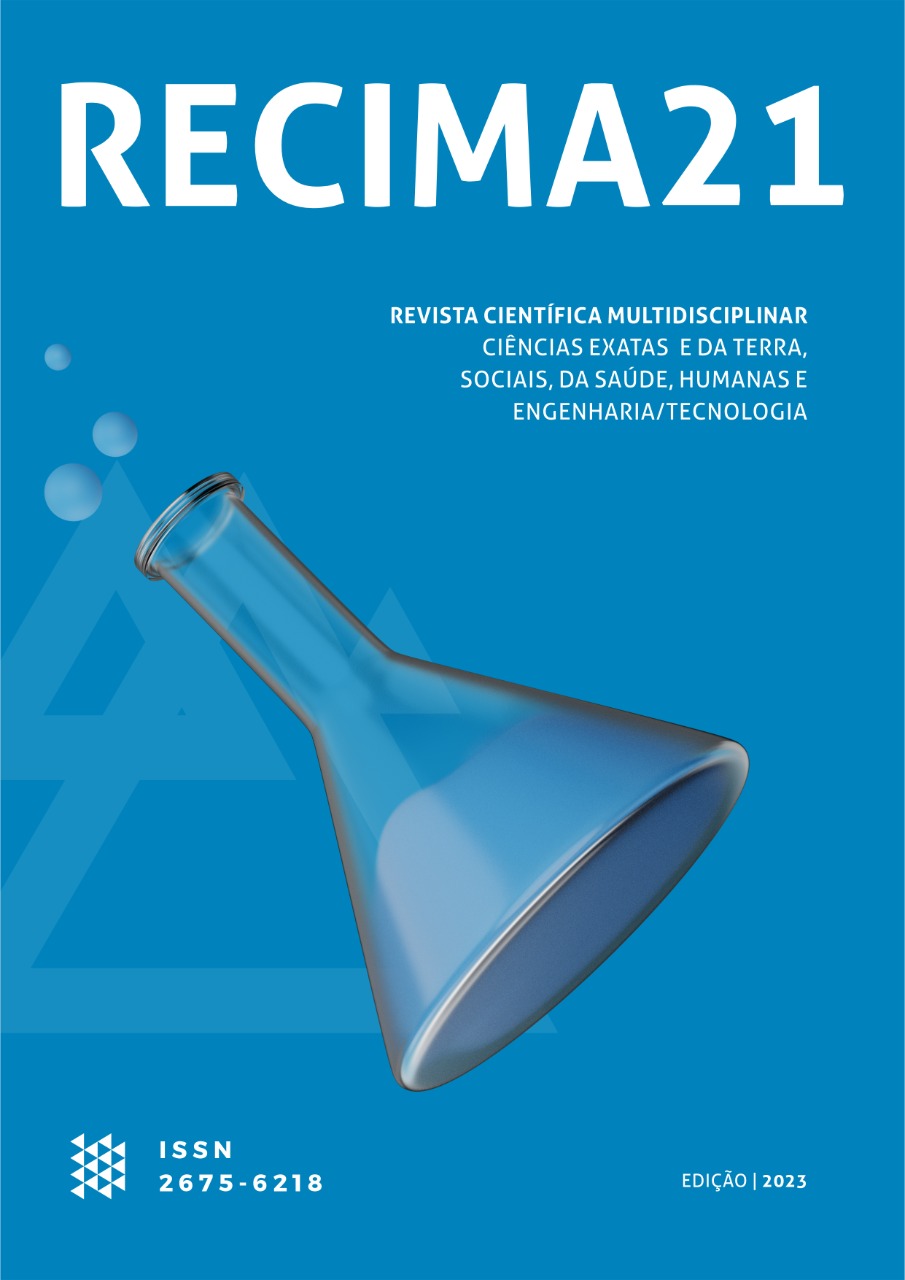SOBRE LA ESTRUCTURA FLORAL Y LOS COLLETERS Y SU RELACIÓN CON LA SISTEMÁTICA Y EVOLUCIÓN EN ALGUNAS ESPECIES DE RUBIACEAE
DOI:
https://doi.org/10.47820/recima21.v4i1.2612Palabras clave:
literatura revela que las tribus Psychotrieae y SpermacoceaeResumen
La literatura revela que las tribus Psychotrieae y Spermacoceae (Rubiaceae) tienen problemas de delimitación de géneros y especies y sugiere la necesidad de más estudios, particularmente de naturaleza morfológica. En este contexto, la presente investigación tiene como objetivo estudiar la estructura floral y la morfología de los colleters de nueve especies de ambas tribus. El análisis se realizó sobre capullos florales y flores de material botánico obtenido de plantas recolectadas en diferentes vegetaciones y execados de diversos herbarios. El material botánico fue incrustado en historresina y seccionado en micrótomo de rotación. Los sépalos exhiben mesófilos homogéneos o dorsiventrales. Los pétalos, en general, tienen mesofililo homogéneo. Los colleters pertenecen al tipo estándar, evidenciando diferencias especialmente en la morfología del pedúnculo. Todas las especies tienen compitum y pueden considerarse eussincárpicas. El ovario es inferior y exhibe placentación basal en Psychotrieae y axial en Spermacoceae. Caracteres como la ausencia de haces vasculares invertidos en la pared del ovario y la vascularización ascendente de los óvulos indican la naturaleza apendicular del ovario. Algunos caracteres relacionados con periant, colleters y vascularización de la pared y tabique del ovario pueden ser útiles en la separación de especies. El tipo de placentación es de carácter seguro para separar Psychotrieae de Spermacoceae.
Descargas
Referencias
ALMEIDA, O.J.G.; PAOLI, A.A.S.; SOUZA, L.A. Flower morpho-anatomy in Epiphyllum phyllanthus (Cactaceae). Revista Mexicana de Biodiversidad, v. 81, p. 65-80, 2010.
BREMER, B.; ERIKSSON, T. Time tree of Rubiaceae: phylogeny and dating the family, subfamilies, and tribes. International Journal of Plant Sciences, v. 170, n. 6, p. 766-793, 2009.
CARLQUIST, S. Toward acceptable evolutionary interpretations of floral anatomy. Phytomorphology, v. 19, p. 332-362, 1969.
COELHO, C.P.; BARBOSA, A.A.A. Biologia reprodutiva de Palicourea macrobotrys Ruiz & Pavon (Rubiaceae): um possível caso de homostilia no gênero Palicourea Aubl. Revista Brasileira de Botânica, v. 26, p. 403-413, 2003.
COELHO, C.P.; BARBOSA, A.A.A. Biologia reprodutiva de Psychotria poeppigiana Muell. Arg. (Rubiaceae) em mata de galeria. Acta Botanica Brasilica, v. 18, p. 481-489, 2004.
DELPRETE, P.G.; JARDIM, J.G. Systematics, taxonomy and floristics of Brazilian Rubiaceae: An overview about the current status and future challenges. Rodriguésia, v. 63, n.1, p. 101-128, 2012.
DICKISON, W.D. Integrative plant anatomy. San Diego: Harcourt Academic Press, 2000.
DOUGLAS, G.E. The inferior ovary. The Botanical Review, v. 10, p. 125-186, 1944.
ENDRESS, P.K. Diversity and evolutionary biology of tropical flowers. Cambridge: Cambridge University Press, 1994.
EVERT, R.F. Anatomia das plantas de Esau: meristemas, células e tecidos do corpo da planta: sua estrutura, função e desenvolvimento. São Paulo: Blucher, 2013.
GUERRITS, P.O. The application of glycolmethacrylate in histiotechnology: some fundamental principles - Gröningen, Netherlands: Department of Anatomy and Embryology, 1991.
JUDD, W. S., CAMPBELL, C. S., KELLOGG, E. A., STEVENS, P. F. Plant systematics - a phylogenetic approach. Sunderland: Sinauer Associates, 1999.
JUDKEVICH, M.D.; SALAS, R.M.; GONZALEZ, A.M. Colleters in American Spermacoceae genera (Rubiaceae): morphonatomical and evolutionary aspects. International Journal of Plant Science, v. 178, n. 5, p. 378–397, 2017.
LERSTEN, N.R. Morphology and distribution of colleters and cristals in relation to the taxonomy and bacterial leaf nodule symbiosis of Psychotria (Rubiaceae). American Journal of Botany, v. 61, p. 973-981, 1974a.
LERSTEN, N.R. Colleter morphology in Pavetta, Neorosea and Tricalysia (Rubiaceae) and its relationship to the bacterial leaf nodule symbiosis. Botanical Journal of Linnean Society, v. 69. p. 125-136. 1974b.
LERSTEN, N.R. Colleter types in Rubiaceae, especially in relation to the bacterial leaf nodule symbiosis. Botanical Journal of the Linnean Society, v. 71, n. 4, p. 311–319. 1975.
O’BRIEN, T.P.; FEDER, N.; MCCULLY, M.E. Polychromatic staining of plant cell walls by toluidine blue O. Protoplasma, v. 59, p. 368-373, 1964.
RAMOS, C.H. Estrutura da flor em gêneros de Spermacoceae sensu lato (Rubiaceae): contribuições para a taxonomia e filogenia. Dissertação de mestrado. Maringá: Universidade Estadual de Maringá, 2022.
ROTH, I. Fruits of angiosperms. In: K. Linsbauer (ed.). Encyclopedia of plant anatomy. Berlin: Gebrüder Borntrager, 1977. pp. 1–675.
SANTOS, A.F.; OLIVEIRA, A.C.; HARTHMAN, V.C.; ROMAGNOLO, M.B.; SOUZA, L.A. Can fruit ontogenetic features prove an important tool in the circumscription of Psychotrieae alliance? Australian Systematic Botany, v. 34, p. 527-540, 2021.
SMITH, F. H.; SMITH, E. C. Anatomy of the inferior ovary of Darbya. American Journal of Botany, v. 29, p. 464- 471, 1942.
SOUZA, L.A. Botânica estrutural: morfologia e anatomia de traqueófitas. Ponta Grossa: Editora UEPG, 2022. (in press)
SOUZA, L.A.; LEMOS, G.F.; BORTOLATTO, A.R.; OLIVEIRA, J.H.G. Flower structure and fruit ontogeny of Richardia brasiliensis Gomes and Diodia radula (Willd.) Cham. & Schltdl. (Rubiaceae). Revista Concilium, v. 22, n. 4, p. 867-874, 2022.
THOMAS, V. Structural, functional and phylogenetic aspects of the colleter. Annals of Botany, v. 68. p. 287-305. 1991.
VITARELLI, N.C.; SANTOS, M. Anatomia de estípulas e coléteres de Psychotria carthagenensis Jacq. (Rubiaceae). Acta Botanica Brasilica, v. 23, n. 4, p. 923-928, 2009.
WEBERLING, F. Morphology of flowers and inflorescences. Cambridge: Cambridge University Press, 1992.
Descargas
Publicado
Número
Sección
Categorías
Licencia
Derechos de autor 2023 RECIMA21 - Revista Científica Multidisciplinar - ISSN 2675-6218

Esta obra está bajo una licencia internacional Creative Commons Atribución 4.0.
Os direitos autorais dos artigos/resenhas/TCCs publicados pertecem à revista RECIMA21, e seguem o padrão Creative Commons (CC BY 4.0), permitindo a cópia ou reprodução, desde que cite a fonte e respeite os direitos dos autores e contenham menção aos mesmos nos créditos. Toda e qualquer obra publicada na revista, seu conteúdo é de responsabilidade dos autores, cabendo a RECIMA21 apenas ser o veículo de divulgação, seguindo os padrões nacionais e internacionais de publicação.













